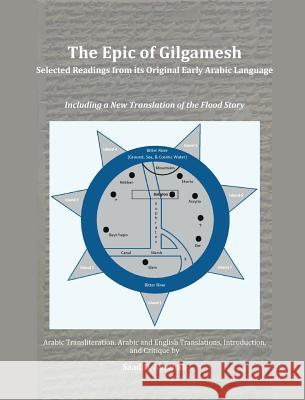The Epic of Gilgamesh: Selected Readings from its Original Early Arabic Language: Including a New Translation of the Flood Story » książka
The Epic of Gilgamesh: Selected Readings from its Original Early Arabic Language: Including a New Translation of the Flood Story
ISBN-13: 9780998172729 / Angielski / Twarda / 2016 / 388 str.
The Epic of Gilgamesh: Selected Readings from its Original Early Arabic Language: Including a New Translation of the Flood Story
ISBN-13: 9780998172729 / Angielski / Twarda / 2016 / 388 str.
(netto: 214,13 VAT: 5%)
Najniższa cena z 30 dni: 225,46
ok. 16-18 dni roboczych
Bez gwarancji dostawy przed świętami
Darmowa dostawa!
The pioneering work presented in this book introduces the earliest known literary and mythology work in the world, the Epic of Gilgamesh, in its actual language: early Classical Arabic. It provides a more accurate translation and understanding of the important story of the flood, one of the key stories of the monotheistic religions. In this book, the author, a known Arabic type designer and an independent scholar of Nabataean, Musnad, and early Arabic scripts, was able to decipher the actual meanings and pronunciations of several important names of ancient Mesopotamian gods, persons, cities, mountains, and other entities. He was able to uncover the evolution path of the concept of god and the background themes behind the rise of the monotheistic religions. Utilizing a generous text sample from the Akkadian and Sumerian languages, this book is an excellent reference textbook for scholars and students of Arabic and Assyriology who are interested in translating these ancient languages through both, the historical Arabic etymological references and the deciphering tools of Assyriology. To illustrate his breakthrough Arabic-based deciphering methodology, the author used a sample text consisting of more than 900 lines from three tablets of the Standard and Old Babylonian editions of the Epic of Gilgamesh. By "digging out" the actual language of the epic, he was not only able to resurrect the actual word soundings and linguistic literary style of its original text, but also to provide more accurate and coherent translations. Following his three years of research, he was able to demonstrate through undisputed linguistic evidence that the epic was in fact written in a beautiful, powerful early Classical Arabic language And the so-called Sumerian and Akkadian languages that the epic was recorded with, which we are told today are unrelated languages, were in fact one evolving early Arabic language, written with one evolving writing system, passing through two major time periods. Although this book is primarily written as a reference textbook for scholars, it is equally suitable for anyone interested in reading the translation of the Epic of Gilgamesh, a fascinating Mesopotamian Arab mythology work documenting eloquently some of the most important and lasting ancient myths invented by humankind.
The pioneering work presented in this book introduces the earliest known literary and mythology work in the world, the Epic of Gilgamesh, in its actual language: early Classical Arabic. It provides a more accurate translation and understanding of the important story of the flood, one of the key stories of the monotheistic religions. In this book, the author, a known Arabic type designer and an independent scholar of Nabataean, Musnad, and early Arabic scripts, was able to decipher the actual meanings and pronunciations of several important names of ancient Mesopotamian gods, persons, cities, mountains, and other entities. He was able to uncover the evolution path of the concept of god and the background themes behind the rise of the monotheistic religions. Utilizing a generous text sample from the Akkadian and Sumerian languages, this book is an excellent reference textbook for scholars and students of Arabic and Assyriology who are interested in translating these ancient languages through both, the historical Arabic etymological references and the deciphering tools of Assyriology. To illustrate his breakthrough Arabic-based deciphering methodology, the author used a sample text consisting of more than 900 lines from three tablets of the Standard and Old Babylonian editions of the Epic of Gilgamesh. By “digging out” the actual language of the epic, he was not only able to resurrect the actual word soundings and linguistic literary style of its original text, but also to provide more accurate and coherent translations. Following his three years of research, he was able to demonstrate through undisputed linguistic evidence that the epic was in fact written in a beautiful, powerful early Classical Arabic language! And the so-called Sumerian and Akkadian languages that the epic was recorded with, which we are told today are unrelated languages, were in fact one evolving early Arabic language, written with one evolving writing system, passing through two major time periods. Although this book is primarily written as a reference textbook for scholars, it is equally suitable for anyone interested in reading the translation of the Epic of Gilgamesh, a fascinating Mesopotamian Arab mythology work documenting eloquently some of the most important and lasting ancient myths invented by humankind.











